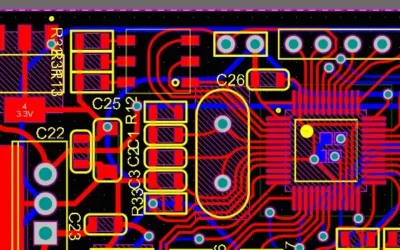Back to blog
LED PCB Design Tips: Best Practices for Manufacturers

LED PCB
The ubiquity of LED PCBs in today’s electronic devices is undeniable. These tiny circuit boards, hosting Light Emitting Diodes (LEDs), have left an indelible mark on our daily lives. From the toys we play with at home to the streetlights that illuminate our cities, LED PCBs have revolutionized the world of electronics. Their widespread adoption can be attributed to the numerous advantages they offer, including high efficiency, cost-effectiveness, and compact design. In this article, we delve into the intricacies of LED PCB design, aiming to empower manufacturers and designers to create LED PCBs tailored to their specific needs.
The Significance of LED PCBs
LED PCBs serve as the backbone of LED lighting systems, making them integral to a multitude of lighting applications. Their usage extends to various domains, including consumer electronics, automotive lighting, architectural lighting, signage, and industrial illumination. The following section outlines the compelling reasons for incorporating LED PCBs into designs.
Lightweight and Compact: LEDs are known for their small size and low weight, making them ideal for applications where space is limited. They find homes in devices such as smartphones, computers, vehicle lights, and traffic signals.
Energy Efficiency: LEDs are champions of energy efficiency, capable of reducing electricity consumption by up to 80%. This attribute makes them the preferred choice for residential lighting, where energy savings are paramount.
Durability: High-quality LED PCBs are designed to resist moisture and dust, making them suitable for industrial environments where protection against these elements is crucial.
Extended Lifespan: LEDs boast an impressive lifespan, up to 25 times that of traditional light sources. This longevity has endeared them to automotive and appliance manufacturers.
Environmental Friendliness: Unlike traditional bulbs, LEDs are mercury-free, posing minimal harm to the environment. They can be easily recycled without complex disposal procedures, significantly reducing environmental pollution.
High Efficiency: LEDs primarily convert electrical energy into light, minimizing wastage as heat. In contrast, traditional bulbs dissipate most energy as heat, resulting in higher power costs.
Challenges in LED PCB Design
While LED PCBs offer numerous advantages, they also present unique challenges that designers must address to maximize their potential. These challenges center around the impact of heat on LED performance:
Temperature: LEDs generate heat during operation, and excessive heat can compromise their lifespan and alter the color of emitted light. Proper thermal management is essential to mitigate these effects.
Lifespan: Elevated temperatures can reduce the lifespan of LEDs, contrary to their reputation for durability.
Color Consistency: LEDs are employed to deliver specific colors in various LED applications. Temperature fluctuations can cause variations in color rendering, necessitating effective thermal management.
Design Considerations for LED PCBs
Designing LED PCBs requires careful consideration of several key factors to ensure optimal performance. These considerations encompass component placement, material selection, thermal management, tracking, and surface finishes, all of which contribute to the board’s ability to support LED operation.
- Component Placement:
- Thoughtful component placement is essential for LED PCB design. Strategic placement reduces manufacturing costs, enhances ease of assembly, and ensures high-quality production.
- In addition to LEDs, other components such as connectors, active and passive components, resistors, and thermistors must be positioned on the PCB. Proper spacing between components is crucial to prevent overvoltage events. Therefore, when designing an LED PCB, we need to consider the creepage (the shortest distance between components) and the clearance (the distance between components measured through the air).
- PCB Materials:
- LED PCBs commonly employ two materials: FR4 and insulated metal substrate (IMS). Each material offers distinct advantages and disadvantages, impacting cost and thermal performance.
- Material selection must facilitate heat dissipation while providing electrical insulation for conductors and supporting interconnections between individual components. Aluminum is often chosen as the metal base layer in IMS-based LED PCBs for its superior heat dissipation properties.
- Thermal Management:
- Effective thermal management is critical in LED PCB design. Heat can negatively affect LED performance and lifespan.
- Strategies such as aluminum cores, thermal vias, and heat sinks are implemented to dissipate heat generated by conductors and components. Careful component placement and LED arrangement ensure even heat distribution for optimal reliability.
- Tracking:
- Tracking involves the creation of routing paths for electrical traces on the PCB. Careful tracking prevents open circuits, short circuits, and crosstalk, ensuring high-quality and reliable PCBs.
- Proper trace routing controls current distribution and prevents overheating. Considerations include track width, tracking space, and the placement of mounting holes.
- Surface Finishes:
- Surface finishes protect exposed copper and provide a solderable surface for component attachment. Common surface finishes include HASL (Hot Air Solder Leveling), OSP (Organic Solderability Preservative), electrolytic nickel/gold, and immersion tin/silver.
- Choosing the right surface finish involves assessing the pros and cons of each option, considering the PCB’s requirements, and adhering to budget constraints.

Types of LED PCB Designs
LED PCBs come in various designs, each suited to specific application needs:
- Single-Sided LED PCB Design:
- Single-sided LED PCBs have only one conductive layer. They are ideal for low-density designs, offering simplicity, cost-effectiveness, and ease of repair. They are well-suited for high-volume orders.
- Double-Sided LED PCB Design:
- Double-sided LED PCBs feature circuit traces on both sides. They provide greater design flexibility, lower costs, and enhanced heat dissipation. These PCBs can accommodate more complex circuit designs and utilize Through Hole Technology (THT) or Surface Mount Technology (SMT) for component assembly.
- Multilayer LED PCB Design:
- Multilayer LED PCBs consist of more than two layers of printed circuit boards. They excel in hardware LED lighting systems, offering benefits like compact size, higher assembly density, durability, flexibility, and powerful single connection points.
Criteria for Choosing an LED PCB Design Service Provider
Selecting the right LED PCB design service provider is crucial for achieving high-quality results. Consider the following criteria when making your choice:
- On-Time Delivery:
- Timely delivery is essential to avoid business disruptions. Faster lead times enable quicker product launches, helping you stay competitive.
- Specialization:
- Seek manufacturers with expertise in LED PCB design. They can provide valuable insights to reduce costs without compromising quality.
- Expertise:
- Ensure that the service provider’s design team is proficient in LED PCB design software and techniques.
- Customer Support:
- Choose a manufacturer known for excellent customer service and technical support. Their responsive team should be readily available to address inquiries and provide guidance.
Manufacturing Process and Testing
A robust quality control and testing process is essential for ensuring reliable production and assembly of PCBs. Close monitoring of key parameters is crucial to verify that the boards meet specifications.
For surface-mount technology (SMT) LEDs, use solder paste specifically designed for heat-sensitive components. Employing nitrogen reflow can help prevent oxidation. Thoroughly inspect solder joints and fillets after reflow, and consider using X-ray inspection to detect hidden flaws.
When working with through-hole LEDs, reinforce mechanical strength by incorporating redundant solder holes and/or screws. The use of flux can help prevent solder bridges between connections. Ensure thorough cleaning after soldering.
Conduct 100% automated optical inspection (AOI) after SMT assembly to identify common defects such as missing or misaligned components. In-circuit testing (ICT) should be performed to verify net connectivity and detect short circuits.
Perform in-circuit testing to validate proper current draws and ensure LED functionality. Programmable power supplies facilitate current ramping and thermal cycling tests.
During hot testing at maximum current loads, monitor LED voltages and junction temperatures. Thermal imaging cameras can be utilized to identify hot spots. Burn-in screening can accelerate the identification of early component failures.
Quality control testing should encompass metrics such as luminous flux, chromaticity, LED orientation, and markings. Additionally, visually inspect the illumination pattern for uniformity.
By implementing rigorous testing protocols throughout volume production, manufacturers can consistently deliver high-quality LED boards that are reliable and perform at a high level.
Choose Highleap Electronic as Your LED PCB Design Service Provider
At Highleap Electronic, we understand the intricacies of LED PCB design. Our experienced engineers utilize cutting-edge CAD software to craft LED circuits in single, double, or multilayer PCBs. We offer custom circuit board solutions tailored to your application and requirements. From initial design and prototyping to assembly and fabrication, we accompany you through the entire process. Contact us today to leverage our PCB design, manufacturing, and assembly capabilities.
Conclusion
The widespread adoption of LED PCBs has transformed the world of electronics. Their lightweight, energy-efficient, and durable nature makes them ideal for a multitude of applications. However, designers and manufacturers must navigate various design considerations, including component placement, material selection, thermal management, tracking, and surface finishes, to fully harness the potential of LED PCBs. By addressing these key factors, they can create innovative and reliable products that illuminate our lives and contribute to a more sustainable future.
Related Articles
Key Considerations in High-Frequency RF Board Design
We’ll explore advanced techniques, common pitfalls, and emerging trends that are shaping the future of high-frequency circuit design.
Analysis of Power Supply Noise in HF PCB Design Process
This comprehensive guide explores the complexities of power supply noise, its origins, and advanced techniques to mitigate its effects in high-frequency PCB designs.
What is EMI, EMS and EMC?
At Highleap Electronic, we specialize in producing high-quality PCBs by integrating advanced techniques for impedance control, ensuring robust EMC and mitigating EMI.
Take a Quick Quote




